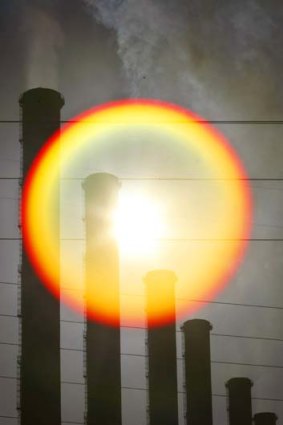By Ben Cubby
GREENHOUSE gases have risen to their highest level since modern humans evolved, and Australian temperatures are now about a degree warmer than they were a century ago, a major review by the CSIRO and the Bureau of Meteorology has found.
The national climate report, to be released today, said Australia's current climate ''cannot be explained by natural variability alone'' and that emissions resulting from human activity were playing an increasingly direct role in shaping temperatures.

Record levels ... greenhouse gases are now 390 parts per million in the atmosphere - the highest since modern humans evolved.Credit: Reuters
Australian researchers were able to identify the ''fingerprint'' of the carbon dioxide particles in the atmosphere, by testing the isotopes in CO2 particles, and confirm that the increase came from fossil fuels burnt in power stations and cars.
''We saw a dip in carbon dioxide emissions during the global financial crisis, but that period is now over,'' said the chief executive of the CSIRO, Megan Clark. ''Levels are now rising steadily again, in line with the trend.''
The carbon dioxide levels in the atmosphere reached 390 parts per million in 2011, the highest level in 800,000 years.
The average day and night-time temperatures in Australia are now about a degree higher than they were a century ago, the State of the Climate 2012 report said.
''Multiple lines of evidence show that global warming continues and that human activities are mainly responsible,'' it said.
The report gathered observations from thousands of experiments, mapping increases in air and water temperature and plotting rising sea levels.
Data gathered from gauges around the coast showed sea levels continuing to rise off Sydney and much of the NSW coast at a rate of about 5 millimetres per year, while some areas of the tropics, including Darwin, are seeing rises of up to 1 centimetre per year. Most of the rise is attributed to thermal expansion, or warmer water temperatures meaning that H20 molecules take up more space.
''The observed global-average mean sea-level rise since 1990 is near the high end of projections from the 2007 Intergovernmental Panel on Climate Change Fourth Assessment Report,'' the researchers found.
On average, global sea levels are about 21 centimetres higher today than they were in 1880, when reliable records began to be kept. The report also noted increases in heavy rainfall events across most of eastern Australia, but also more bushfires. The trend for Sydney is towards more monsoonal rains.
''The Mediterranean weather we have become used to seems to be fading,'' Dr Clark said.
A CSIRO atmospheric scientist, Paul Fraser, said the world was now on track to pass the 400 parts per million level for CO2 emissions in under five years.
Researchers at an air monitoring station at Cape Grim in Tasmania have been testing the composition of carbon dioxide molecules. The measurements include a form of ''carbon dating'', where the amount of carbon-14 particles indicates the age of a particle.
''The only process you can come up with that fits the profile of the CO2 we measure is the combustion of fossil fuels,'' Dr Fraser said.
Observations at Cape Grim have been tracking the changing composition of the air for decades. Since 2000, fossil fuel emissions in CO2 samples have been increasing by about 3 per cent a year, but a decline of about 1.2 per cent a year took place as energy demand slackened during the financial crisis.
Growth in human-induced CO2 emissions has now rebounded back to about 5.9 per cent a year, the report said.